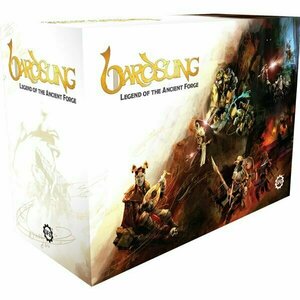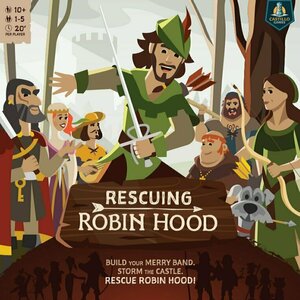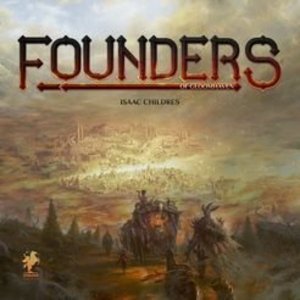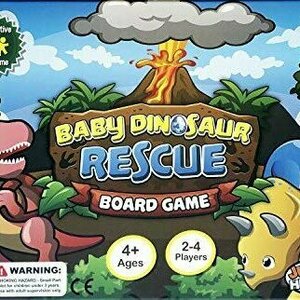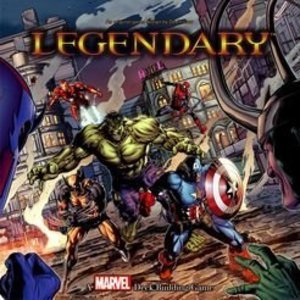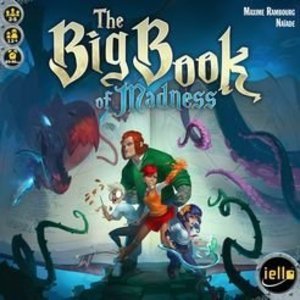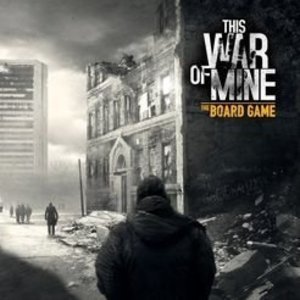Search

Sky Gamblers: Storm Raiders
Games and Entertainment
App
Apple Design Award 2013 Winner! Launched as Editor's choice on the AppStore! Slide To Play - 4 out...
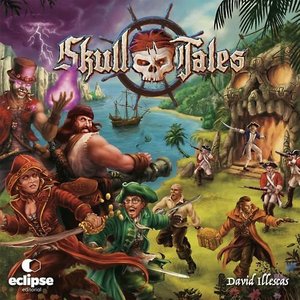
Skull Tales: Full Sail!
Tabletop Game
Skull Tales: Full Sail! Is a semi-cooperative pirate adventure game for 1 to 5 players. In Skull...
Boardgames Pirategames 2018Games
Purple Phoenix Games (2266 KP) rated Rescuing Robin Hood in Tabletop Games
Nov 10, 2020
I have a secret to tell you all. I love the Robin Hood IP, even though my only real knowledge of it comes from the “Robin Hood: Men in Tights” and “Robin Hood: Prince of Thieves” movies. I have never read the story, nor have I ever watched the Errol Flynn movie. So why do I love Robin Hood so much? I really can’t tell you for sure, it just seems like such a fun theme with lots of characters and an interesting central plot. So how does this quasi-deck-builder fare? Faire? I think fare. Let’s find out.
Rescuing Robin Hood is a cooperative card drafting and deck building game with multiple value usage on each card and, at least in my very first play, the humbling experience of having over 20 guards protecting the Sheriff of Nottingham. Players will win once Robin Hood is rescued, but may achieve an ultimate victory by defeating the Sheriff and his guard detail.
DISCLAIMER: We were provided a prototype copy of this game for the purposes of this review. These are preview copy components, and I do not know for sure if the final components will be any different from these shown. Also, it is not my intention to detail every rule in the game, as there are just too many. You are invited to download the rulebook, back the game through the Kickstarter campaign launching November 10, 2020, or through any retailers stocking it after fulfillment. -T
To setup, follow the setup suggestion in the rulebook. The game should roughly look how it is below in the photo. Roughly. The components include cards for Nottingham Castle, the Sheriff, his guards, Robin Hood, his band of Merry Men, other recruitable villagers, and a Tracker Card. Along with all the cards, inside the box are tracker cubes and ability chips. Once the game is setup, determine the starting player and the game may begin!
A game of Rescuing Robin Hood lasts five rounds (or “days” to rescue the hero from being executed). Each round has players dealing four cards from their draw decks and using these four villagers in conjunction with their chosen Merry Men character card to create values on the Tracker Card for Wit, Stealth, Brawn, and Jolliness. Some villagers or characters will also provide the player with ability chips to be used during the turn. These include Prayer (which can move guards from one group to another, or eliminate a guard entirely – the power of prayer is REAL), Cookery (which can be used to increase the values of Wit, Stealth, or Brawn by +2 for each chip), and Scouting (which allows a player to reveal a face-down guard card in any group).
Once the active player has adjusted all their values they wish, they may now begin attacking guards. Per the setup card for each round a group of guards are holding villagers captive and they must be defeated in order to free the villagers to be recruited to players’ decks. In order to defeat a guard or entire groups of guards, players will be attacking twice using their Wit, Stealth, and/or Brawn values.
To attack with Wit, the active player will determine which group of guards they will attack and target the face-up guard at the end of the group. If defeated, the player will reduce their total Wit by the value of Wit they expended to defeat the first guard. Should they wish to continue attacking guards with Wit, they must state this before flipping the next guard face-up. This adds the push-your-luck element to the game. Should the player wish to stop, the guards are defeated. Should the player bust, the entire collection of guards previously outwitted are added back to the group face-up to be defeated by another player or by the same player using a different attack method.
If the active player wishes to use Stealth to attack guards, they must choose a group of guards and pick them off one by one. Using their total Stealth value and decreasing it with each successful attack, the player will choose one or more (face-up or face-down) guards to attack. Again, should they succeed the guards will be defeated and removed from play. Should the player bust by attempting to pick off too many guards, then all guards are added back to the group face-up.
Using Brawn to attack guards requires the active player to choose a group of guards and attack the ENTIRE group using their Brawn value. Should the player succeed in defeating all guards in the group (no matter the size of the group) then all guards are removed from play. If the player fails, as always, the guards are returned to the group to taunt the next player.
Active players will be able to attack guards twice on a turn but must use two different attack methods. Should the player end their turn with remaining Brawn or Jolliness values, those values will be passed along to the next player in turn order to be used. Additionally, should the next player end their turn with Brawn or Jolliness, they will be passed to the next player and so on.
At the end of each round villagers that were freed of guards during the round will be drafted to players’ decks. At the end of round 2 and 4 players’ decks will be thinned by choosing which villagers stay and which will aid the players in the final round. The final round of Rescuing Robin Hood pits the players against the walls of Nottingham Castle, a Courtyard full of guards, and even Sheriff Nottingham and his personal guards. Again, should the players defeat the Castle walls and Courtyard, they free Robin Hood and win the game. If the players are feeling particularly confident they may also challenge the Sheriff for ultimate victory.
Components. Again, this is a prototype copy of the game using prototype components. That said, the components we received are truly excellent. Firstly, the art style throughout the game is crisp and colorful and a lot of fun. Some of the names of the villagers are downright silly and punny and I absolutely love that. The cards are all wonderful, and the cubes are normal game cubes (not Nintendo-related), and hopefully they will be upgraded via a successful Kickstarter campaign. All in all the components are great and the art is quite enjoyable.
So do I like Rescuing Robin Hood? Oh yes, quite a bit! This game exercises my brain so much without having to labor for minutes on end creating strategies and alternate strategies. I enjoy being able to just barrel into a group of guards and take out the entire swath of them using my extreme Brawniness. Need to pump up before a fight? Well obviously I’ll use up my Jolliness to boost my confidence or narrow my concentration. I purposely omitted several rules so as not to bog down my review any further, but there are so many interesting little flecks of mechanics working together to create a cohesive gaming experience and it is simply delicious.
While Rescuing Robin Hood is not incredibly heavy, there are tons of choices to be made and risks to be taken to achieve ultimate victory. I enjoy being able to tailor my deck with powerful villagers, or specialize in two attack values to unload on guards. Having players that use interesting mixes of Merry Men characters also increases the enjoyment as this game is absolutely cooperative and players may assist each other in many ways. Need some extra Wit for your turn coming up? Here, let me pass along my extra Jolliness to you to use. Want some Cookery too? Go ahead, I’ve got plenty to share. Oh, such great feelings at the table being able to share resources like this.
So I urge you, dear reader, to check out the Kickstarter campaign for Rescuing Robin Hood. If you enjoy lighter (but not tooooo light) cooperative, card drafting, deck building games with a great theme, you need to pick up a copy of Rescuing Robin Hood. I didn’t see Blinkin or Ahchoo in the game, but that’s not to say Castillo Games doesn’t have these hiding in stretch goals (I really don’t know if they are in the plans, but they SHOULD be).
Rescuing Robin Hood is a cooperative card drafting and deck building game with multiple value usage on each card and, at least in my very first play, the humbling experience of having over 20 guards protecting the Sheriff of Nottingham. Players will win once Robin Hood is rescued, but may achieve an ultimate victory by defeating the Sheriff and his guard detail.
DISCLAIMER: We were provided a prototype copy of this game for the purposes of this review. These are preview copy components, and I do not know for sure if the final components will be any different from these shown. Also, it is not my intention to detail every rule in the game, as there are just too many. You are invited to download the rulebook, back the game through the Kickstarter campaign launching November 10, 2020, or through any retailers stocking it after fulfillment. -T
To setup, follow the setup suggestion in the rulebook. The game should roughly look how it is below in the photo. Roughly. The components include cards for Nottingham Castle, the Sheriff, his guards, Robin Hood, his band of Merry Men, other recruitable villagers, and a Tracker Card. Along with all the cards, inside the box are tracker cubes and ability chips. Once the game is setup, determine the starting player and the game may begin!
A game of Rescuing Robin Hood lasts five rounds (or “days” to rescue the hero from being executed). Each round has players dealing four cards from their draw decks and using these four villagers in conjunction with their chosen Merry Men character card to create values on the Tracker Card for Wit, Stealth, Brawn, and Jolliness. Some villagers or characters will also provide the player with ability chips to be used during the turn. These include Prayer (which can move guards from one group to another, or eliminate a guard entirely – the power of prayer is REAL), Cookery (which can be used to increase the values of Wit, Stealth, or Brawn by +2 for each chip), and Scouting (which allows a player to reveal a face-down guard card in any group).
Once the active player has adjusted all their values they wish, they may now begin attacking guards. Per the setup card for each round a group of guards are holding villagers captive and they must be defeated in order to free the villagers to be recruited to players’ decks. In order to defeat a guard or entire groups of guards, players will be attacking twice using their Wit, Stealth, and/or Brawn values.
To attack with Wit, the active player will determine which group of guards they will attack and target the face-up guard at the end of the group. If defeated, the player will reduce their total Wit by the value of Wit they expended to defeat the first guard. Should they wish to continue attacking guards with Wit, they must state this before flipping the next guard face-up. This adds the push-your-luck element to the game. Should the player wish to stop, the guards are defeated. Should the player bust, the entire collection of guards previously outwitted are added back to the group face-up to be defeated by another player or by the same player using a different attack method.
If the active player wishes to use Stealth to attack guards, they must choose a group of guards and pick them off one by one. Using their total Stealth value and decreasing it with each successful attack, the player will choose one or more (face-up or face-down) guards to attack. Again, should they succeed the guards will be defeated and removed from play. Should the player bust by attempting to pick off too many guards, then all guards are added back to the group face-up.
Using Brawn to attack guards requires the active player to choose a group of guards and attack the ENTIRE group using their Brawn value. Should the player succeed in defeating all guards in the group (no matter the size of the group) then all guards are removed from play. If the player fails, as always, the guards are returned to the group to taunt the next player.
Active players will be able to attack guards twice on a turn but must use two different attack methods. Should the player end their turn with remaining Brawn or Jolliness values, those values will be passed along to the next player in turn order to be used. Additionally, should the next player end their turn with Brawn or Jolliness, they will be passed to the next player and so on.
At the end of each round villagers that were freed of guards during the round will be drafted to players’ decks. At the end of round 2 and 4 players’ decks will be thinned by choosing which villagers stay and which will aid the players in the final round. The final round of Rescuing Robin Hood pits the players against the walls of Nottingham Castle, a Courtyard full of guards, and even Sheriff Nottingham and his personal guards. Again, should the players defeat the Castle walls and Courtyard, they free Robin Hood and win the game. If the players are feeling particularly confident they may also challenge the Sheriff for ultimate victory.
Components. Again, this is a prototype copy of the game using prototype components. That said, the components we received are truly excellent. Firstly, the art style throughout the game is crisp and colorful and a lot of fun. Some of the names of the villagers are downright silly and punny and I absolutely love that. The cards are all wonderful, and the cubes are normal game cubes (not Nintendo-related), and hopefully they will be upgraded via a successful Kickstarter campaign. All in all the components are great and the art is quite enjoyable.
So do I like Rescuing Robin Hood? Oh yes, quite a bit! This game exercises my brain so much without having to labor for minutes on end creating strategies and alternate strategies. I enjoy being able to just barrel into a group of guards and take out the entire swath of them using my extreme Brawniness. Need to pump up before a fight? Well obviously I’ll use up my Jolliness to boost my confidence or narrow my concentration. I purposely omitted several rules so as not to bog down my review any further, but there are so many interesting little flecks of mechanics working together to create a cohesive gaming experience and it is simply delicious.
While Rescuing Robin Hood is not incredibly heavy, there are tons of choices to be made and risks to be taken to achieve ultimate victory. I enjoy being able to tailor my deck with powerful villagers, or specialize in two attack values to unload on guards. Having players that use interesting mixes of Merry Men characters also increases the enjoyment as this game is absolutely cooperative and players may assist each other in many ways. Need some extra Wit for your turn coming up? Here, let me pass along my extra Jolliness to you to use. Want some Cookery too? Go ahead, I’ve got plenty to share. Oh, such great feelings at the table being able to share resources like this.
So I urge you, dear reader, to check out the Kickstarter campaign for Rescuing Robin Hood. If you enjoy lighter (but not tooooo light) cooperative, card drafting, deck building games with a great theme, you need to pick up a copy of Rescuing Robin Hood. I didn’t see Blinkin or Ahchoo in the game, but that’s not to say Castillo Games doesn’t have these hiding in stretch goals (I really don’t know if they are in the plans, but they SHOULD be).
Jason James (3 KP) rated Founders of Gloomhaven in Tabletop Games
Apr 4, 2019
Founders of Gloomhaven is a 1 to 4 player cooperative/competitive game. In short, players must work to build the city of Gloomhaven. The game provides a two-sided board and depending on which side you choose it slightly changes how the game is played. All players choose a character race and any additional resource cards. This determines which resources the players will automatically own during the game. However, other players will have the opportunity to buy access to resources they do not own. This is vital when building "upgraded" buildings. Each player starts with the same five cards (six cards in a two-player game). Players will have a chance to acquire new card by recruiting advisers, which are upgraded versions of the base cards. Play begins with a player laying down a card they wish to play. They follow the instructions on the top of the card, and then each other player will have a chance to follow the instructions laid out on the bottom of the card. Card actions can always be switched out with a set of basic actions (collect one gold or influence, build a road, or place a worker). If a player chooses (or is forced) to play a "Call to Vote" card, they collect one gold or influence, or build one road for each of the remaining cards in their hand. They reset all of their workers and collect their discard pile. All other players have a chance to collect gold based on the number of resources they own. Then all players vote for which prestige building they want to be built. All players reveal their choice token along with any influence they wish to spend. The player with the most votes gets to place the building anywhere on the map. Points are scored by connecting upgraded buildings to resources you own but is slightly more difficult with the games unique "trickle down" scoring system. This means that some points may have to be shared with players who own base the resources or other upgraded building needed to build the building that was just placed.
Overall this game is for people who enjoy other similar games like Catan or Ticket to Ride. Players must adjust to the fact that roads are public tiles that can connect any players resources to buildings. The game is high statistical and players must be able to make decisions that may result in other players gaining points. I would give the game an 8/10 as it brings a fresh feel to city-building board games! If you have any questions or have any comments on my review please feel free to message me.
Thanks!
Overall this game is for people who enjoy other similar games like Catan or Ticket to Ride. Players must adjust to the fact that roads are public tiles that can connect any players resources to buildings. The game is high statistical and players must be able to make decisions that may result in other players gaining points. I would give the game an 8/10 as it brings a fresh feel to city-building board games! If you have any questions or have any comments on my review please feel free to message me.
Thanks!
Purple Phoenix Games (2266 KP) rated Baby Dinosaur Rescue in Tabletop Games
Apr 21, 2021
The Kids Table series from Purple Phoenix Games seeks to lightly explore games that are focused toward children and families. We will do our best to give some good insight, but not bog you down with a million rules.
The island’s volcano is about to erupt! We HAVE to get these baby dinosaurs to safety FAST! Place the game board on the table with the lava tracker token on the highest lava spot. Depending on how challenging you want your game, place all your dinosaur tokens at the bottom of the board ready to move to safety. Shuffle the cards and deal each player three. You are ready to truck it to the safety of a neighboring island.
On your turn you will play a card from your hand and move any dinosaur to the next-closest open spot that matches the card you played. So if you play that Fish Bone card, move one dino to the first Fish Bone spot on the board you see. Draw another card and it’s the next player’s turn. Do they also have a Fish Bone? Great, play it now because the next-closest open Fish Bone spot is the one PAST where you last placed a dino moving them even further ahead!
Uh oh, have a Lava card in your hand? You HAVE to play that first. When a Lava card is played, no dinosaurs move, but the Lava token moves down one spot closer to obliterating the island!
Play continues in this fashion of playing cards and hopefully leap-frogging dinos to move further ahead on the path to safety. Players are playing cooperatively, so either everyone wins when all the dinos get to the other island, or everyone loses because the island has been burninated.
Components. Any game with a trumpet-playing character already has great components. But, the board and chips are good sturdy quality, and the cards are as well. If you find that you will be playing this one quite a bit I would suggest sleeving the cards as they are handled a lot during play.
We love this game and my son requests it more than any other game we own. It is simple, fun, and tense at times! What we love about this game as parents is that it teaches children about cooperative gaming. No dinosaurs are owned in the game – everyone is trying to save ALL the dinos, not just “THEIR” dino. It also teaches that sometimes you have Lava cards and are unable to help the team, and that’s okay because another player will pick up that slack and make the team better. Gotta love educational games with great themes! Pick it up online as I haven’t seen it in stores anywhere.
The island’s volcano is about to erupt! We HAVE to get these baby dinosaurs to safety FAST! Place the game board on the table with the lava tracker token on the highest lava spot. Depending on how challenging you want your game, place all your dinosaur tokens at the bottom of the board ready to move to safety. Shuffle the cards and deal each player three. You are ready to truck it to the safety of a neighboring island.
On your turn you will play a card from your hand and move any dinosaur to the next-closest open spot that matches the card you played. So if you play that Fish Bone card, move one dino to the first Fish Bone spot on the board you see. Draw another card and it’s the next player’s turn. Do they also have a Fish Bone? Great, play it now because the next-closest open Fish Bone spot is the one PAST where you last placed a dino moving them even further ahead!
Uh oh, have a Lava card in your hand? You HAVE to play that first. When a Lava card is played, no dinosaurs move, but the Lava token moves down one spot closer to obliterating the island!
Play continues in this fashion of playing cards and hopefully leap-frogging dinos to move further ahead on the path to safety. Players are playing cooperatively, so either everyone wins when all the dinos get to the other island, or everyone loses because the island has been burninated.
Components. Any game with a trumpet-playing character already has great components. But, the board and chips are good sturdy quality, and the cards are as well. If you find that you will be playing this one quite a bit I would suggest sleeving the cards as they are handled a lot during play.
We love this game and my son requests it more than any other game we own. It is simple, fun, and tense at times! What we love about this game as parents is that it teaches children about cooperative gaming. No dinosaurs are owned in the game – everyone is trying to save ALL the dinos, not just “THEIR” dino. It also teaches that sometimes you have Lava cards and are unable to help the team, and that’s okay because another player will pick up that slack and make the team better. Gotta love educational games with great themes! Pick it up online as I haven’t seen it in stores anywhere.
Purple Phoenix Games (2266 KP) rated Mass Transit in Tabletop Games
May 13, 2021
Remember back in the day when you used to get off work, have to walk a ways to the bus station, then hop a train to the marina so you could grab a boat, and then walk the rest of the way home? No? Just me? Well imagine having to plan six different peoples’ treks home this way. Which way is the easiest? Can they all make it home by dinner time? Did that guy just prematurely jump off the boat to try to get to the train? What am I even doing here?
Mass Transit is a cooperative, network building card game where players take on the roles of urban planners attempting to lay routes for commuters to head to and from work in the Big City. As the game is cooperative, all urban planners either win or lose together. But in either case, it’s the commuteeples (maybe?) that win or lose.
DISCLAIMER: We were provided a copy of this game for the purposes of this review. This is a retail copy of the game, so what you see in these photos is exactly what would be received in your box. I do not intend to cover every single rule included in the rulebook, but will describe the overall game flow and major rule set so that our readers may get a sense of how the game plays. For more in depth rules, you may purchase a copy online or from your FLGS. -T
To setup, assemble the Big City tiles to make a sweet hexagon. Each commuteeple (ok I think I’m not doing this one any longer) is placed on their worksite in the Big City. Shuffle the big deck of Mass Transit cards and deal each player four cards. The players choose a first player and the game may begin!
On a turn players will need to play at least two of their cards and can play up to all four if they wish. The choices of card play are to add it to a route line or discard it for movement. To add the card to the route line, players simply choose a route line and place the card at the end. This extends the route by one card. To finish a route, players will need to place the suburb card at the end of a line with the appropriate number of cards (some suburbs may show a 4, which means they can only be placed once four route cards have been placed in the same line).
The other way to play cards are to discard them for movement. Cards are discarded out of the game and used for the printed movement type. Green cards are walking, blue are ferry, gray are bus, red are train, and yellow are unavailable to use for movement. For example, a player could discard a green walk card in order to move the meeple one card closer to the suburb card, or could use a red train card in order to move the meeple from one train station icon to the next (which could actually move the meeple over several cards at once). There are some movement restrictions, such as the inability for meeples to simply jump out of a vehicle at a Traffic Stop in order to take an alternate movement type.
If the players can all work together (without expressly verbalizing strategy) and move all six meeples to their suburb homes before a player is unable to play two cards from their hands, they win! However, should a player be unable to play the required two cards from their hand and all meeples are not in their comfy homes, the players all lose together in sweet sadness.
Components. I absolutely love the interconnecting Big City tiles. They are just the right size, and even hold the draw deck. Speaking of the deck, the cards are all nice quality with slight linen finish and excellent graphic stylization. Mass Transit looks great on the table and when finished, looks like a funky subway map with little blue meeples. The meeples come with a sticker sheet, and while you can add your favorite stickers to one side of the meeple, we opted to just randomly add stickers to both sides and it works for us. I have zero issues with the components, and have come to expect that from Calliope Games titles.
All in all, this little game packs a great experience into about 15 or 20 minutes. What I really enjoy is trying to figure out the best usage for the cards in hand. Is it better to use the gray card to add to the route or to use it for fast travel (any Skyrim fans out there?)? To add to this thinkiness, the rules explicitly state that players are unable to discuss strategies, but can hint aloud at what they may be considering. So while this is not a silent game, players will need to carefully decide how best to communicate what they wish the party to accomplish without specifically stating such.
Mass Transit is a game that I can easily pull out and play with my 10-year-old twin niece and nephew, with other adults, or with harder gamers. When a small game can be so versatile, it certainly earns a place in my collection. If you are also looking for a small box game with a smallish table footprint and great presence, consider picking up a copy of Mass Transit. Purple Phoenix Games gives this one a blues travelin’ (hehe) 11 / 12. Pro tip: use the yellow cards early and for route addition only, as they cannot be used for movement. Also, stay away from alpha gamers, and they might not be able to handle the communication ban.
Mass Transit is a cooperative, network building card game where players take on the roles of urban planners attempting to lay routes for commuters to head to and from work in the Big City. As the game is cooperative, all urban planners either win or lose together. But in either case, it’s the commuteeples (maybe?) that win or lose.
DISCLAIMER: We were provided a copy of this game for the purposes of this review. This is a retail copy of the game, so what you see in these photos is exactly what would be received in your box. I do not intend to cover every single rule included in the rulebook, but will describe the overall game flow and major rule set so that our readers may get a sense of how the game plays. For more in depth rules, you may purchase a copy online or from your FLGS. -T
To setup, assemble the Big City tiles to make a sweet hexagon. Each commuteeple (ok I think I’m not doing this one any longer) is placed on their worksite in the Big City. Shuffle the big deck of Mass Transit cards and deal each player four cards. The players choose a first player and the game may begin!
On a turn players will need to play at least two of their cards and can play up to all four if they wish. The choices of card play are to add it to a route line or discard it for movement. To add the card to the route line, players simply choose a route line and place the card at the end. This extends the route by one card. To finish a route, players will need to place the suburb card at the end of a line with the appropriate number of cards (some suburbs may show a 4, which means they can only be placed once four route cards have been placed in the same line).
The other way to play cards are to discard them for movement. Cards are discarded out of the game and used for the printed movement type. Green cards are walking, blue are ferry, gray are bus, red are train, and yellow are unavailable to use for movement. For example, a player could discard a green walk card in order to move the meeple one card closer to the suburb card, or could use a red train card in order to move the meeple from one train station icon to the next (which could actually move the meeple over several cards at once). There are some movement restrictions, such as the inability for meeples to simply jump out of a vehicle at a Traffic Stop in order to take an alternate movement type.
If the players can all work together (without expressly verbalizing strategy) and move all six meeples to their suburb homes before a player is unable to play two cards from their hands, they win! However, should a player be unable to play the required two cards from their hand and all meeples are not in their comfy homes, the players all lose together in sweet sadness.
Components. I absolutely love the interconnecting Big City tiles. They are just the right size, and even hold the draw deck. Speaking of the deck, the cards are all nice quality with slight linen finish and excellent graphic stylization. Mass Transit looks great on the table and when finished, looks like a funky subway map with little blue meeples. The meeples come with a sticker sheet, and while you can add your favorite stickers to one side of the meeple, we opted to just randomly add stickers to both sides and it works for us. I have zero issues with the components, and have come to expect that from Calliope Games titles.
All in all, this little game packs a great experience into about 15 or 20 minutes. What I really enjoy is trying to figure out the best usage for the cards in hand. Is it better to use the gray card to add to the route or to use it for fast travel (any Skyrim fans out there?)? To add to this thinkiness, the rules explicitly state that players are unable to discuss strategies, but can hint aloud at what they may be considering. So while this is not a silent game, players will need to carefully decide how best to communicate what they wish the party to accomplish without specifically stating such.
Mass Transit is a game that I can easily pull out and play with my 10-year-old twin niece and nephew, with other adults, or with harder gamers. When a small game can be so versatile, it certainly earns a place in my collection. If you are also looking for a small box game with a smallish table footprint and great presence, consider picking up a copy of Mass Transit. Purple Phoenix Games gives this one a blues travelin’ (hehe) 11 / 12. Pro tip: use the yellow cards early and for route addition only, as they cannot be used for movement. Also, stay away from alpha gamers, and they might not be able to handle the communication ban.
Purple Phoenix Games (2266 KP) rated Legendary: A Marvel Deck Building Game in Tabletop Games
Sep 19, 2019
Teamwork makes the dream work! That’s how the saying goes, right? And in Legendary: A Marvel Deck Building Game, it is certainly the truth! When I say it’s a team-building game, I mean that both literally and figuratively – you must recruit heroes and work semi-cooperatively with your fellow gamers to defeat the evil Mastermind before they take over the city!
In an era where superheroes are the norm, the days of petty crime are over. As the protectors of our world have grown in power, so too have those who would see it fall to chaos. Out of the shadows comes a nefarious Mastermind who has engineered the most wicked evil scheme the world has ever seen. With an ever-growing band of followers and henchmen to carry out the plot, the future looks dismal. But do not fear – the supers are here! This job is way too big for only one single hero to handle, but if they all band together, then maybe, juuuust maybe, they might be able to pull it off…
DISCLAIMER: There are several expansions to this game, but we are not reviewing them at this time. Should we review them in the future we will either update this review or post a link to the new material here. -T
Set in the world of Marvel comics and, recently, the Marvel Cinematic Universe, Legendary: Marvel is a cooperative deck building game. Players take turns drafting and playing cards to recruit heroes to their team and to fight off the villains trying to carry out the sinister scheme. You have to strategize how you want to build your deck to best complete the mission – do you recruit heroes that give you special abilities (like drawing additional cards), or do you recruit strong heroes that give you lots of attack points? The choice is entirely up to you! Although all players are building their own individual decks, you must also devise a team strategy because all players either win or lose together as a team. That being said, there is a small competitive aspect to this game – the player with the most Victory Points (earned by defeating villains and rescuing bystanders) is deemed the most legendary hero of the game! Exactly how competitive the game gets is up to the players. I personally prefer a more cooperative approach and usually don’t tally up VPs at the end of the game – either the team won or we lost.
The beauty of this game is that it can be played with any combination of Marvel characters – you are not limited to only using specific teams. Selecting which heroes/villains/Mastermind/etc. to use is at the discretion of the players. Want Iron Man to team up with Deadpool and Wolverine to fight off Kingpin? Go for it! You have basically the entire Marvel universe from which to choose, so the sky is the limit! With so many options, though, it can be a little overwhelming, so I usually use a randomizer app to create a setup for me. Sometimes the setup itself will determine how the entire game will play out – certain combinations of Mastermind/villains/scheme can be BRUTAL to play and difficult to win. But the cool thing about this game is that you cannot just look at a setup and tell if it will be difficult or not – that realization only will come once you start playing!
I love playing this game because of its immense variability – the base game alone has 500 cards! The ability to choose your own heroes, villains, Masterminds, and Schemes means that you will probably never play the same game twice. And on top of that, Legendary: Marvel currently has like 19 expansions! The possibilities are truly endless, and that is the Holy Grail for me when it comes to gaming. I know that I will never get bored of this game because it is a different experience every game.
On the flip side, my main grievance with Legendary: Marvel is with the physical setup and teardown. Every play uses SO MANY cards that it does take a decent amount of time to get setup or put away. Every individual hero/villain/Mastermind/etc. must be sorted and stored separately, and with 500+ cards, that time adds up. When deciding on a game to play, sometimes I skip Legendary: Marvel because of the time it takes to set up. I LOVE to play it, but sometimes I do not feel like taking that much time to set up – I just want to play! My other grievance deals with certain hero superpowers/special card text. Some hero cards have special text, and the definitions are outlined in the rule book but not on the cards themselves. Until I learned/memorized what that special text meant, I was constantly referring back to the rule book nearly every turn to make sure I was using the cards correctly. There is a bit of a learning curve with some of the hero text, but it does get better the more you play!
Don’t let the simplicity of the mechanics fool you – this game requires more strategy than meets the eye! You must not only decide on a strategy for building your individual deck, but you and your teammates must also collectively choose a group strategy to defeat the Mastermind. Cooperation is key, and it really helps the theme of the game come to life. Definitely a winner for Purple Phoenix Games with a butt-kicking 24 / 24 and a well-earned Golden Feather Award!
In an era where superheroes are the norm, the days of petty crime are over. As the protectors of our world have grown in power, so too have those who would see it fall to chaos. Out of the shadows comes a nefarious Mastermind who has engineered the most wicked evil scheme the world has ever seen. With an ever-growing band of followers and henchmen to carry out the plot, the future looks dismal. But do not fear – the supers are here! This job is way too big for only one single hero to handle, but if they all band together, then maybe, juuuust maybe, they might be able to pull it off…
DISCLAIMER: There are several expansions to this game, but we are not reviewing them at this time. Should we review them in the future we will either update this review or post a link to the new material here. -T
Set in the world of Marvel comics and, recently, the Marvel Cinematic Universe, Legendary: Marvel is a cooperative deck building game. Players take turns drafting and playing cards to recruit heroes to their team and to fight off the villains trying to carry out the sinister scheme. You have to strategize how you want to build your deck to best complete the mission – do you recruit heroes that give you special abilities (like drawing additional cards), or do you recruit strong heroes that give you lots of attack points? The choice is entirely up to you! Although all players are building their own individual decks, you must also devise a team strategy because all players either win or lose together as a team. That being said, there is a small competitive aspect to this game – the player with the most Victory Points (earned by defeating villains and rescuing bystanders) is deemed the most legendary hero of the game! Exactly how competitive the game gets is up to the players. I personally prefer a more cooperative approach and usually don’t tally up VPs at the end of the game – either the team won or we lost.
The beauty of this game is that it can be played with any combination of Marvel characters – you are not limited to only using specific teams. Selecting which heroes/villains/Mastermind/etc. to use is at the discretion of the players. Want Iron Man to team up with Deadpool and Wolverine to fight off Kingpin? Go for it! You have basically the entire Marvel universe from which to choose, so the sky is the limit! With so many options, though, it can be a little overwhelming, so I usually use a randomizer app to create a setup for me. Sometimes the setup itself will determine how the entire game will play out – certain combinations of Mastermind/villains/scheme can be BRUTAL to play and difficult to win. But the cool thing about this game is that you cannot just look at a setup and tell if it will be difficult or not – that realization only will come once you start playing!
I love playing this game because of its immense variability – the base game alone has 500 cards! The ability to choose your own heroes, villains, Masterminds, and Schemes means that you will probably never play the same game twice. And on top of that, Legendary: Marvel currently has like 19 expansions! The possibilities are truly endless, and that is the Holy Grail for me when it comes to gaming. I know that I will never get bored of this game because it is a different experience every game.
On the flip side, my main grievance with Legendary: Marvel is with the physical setup and teardown. Every play uses SO MANY cards that it does take a decent amount of time to get setup or put away. Every individual hero/villain/Mastermind/etc. must be sorted and stored separately, and with 500+ cards, that time adds up. When deciding on a game to play, sometimes I skip Legendary: Marvel because of the time it takes to set up. I LOVE to play it, but sometimes I do not feel like taking that much time to set up – I just want to play! My other grievance deals with certain hero superpowers/special card text. Some hero cards have special text, and the definitions are outlined in the rule book but not on the cards themselves. Until I learned/memorized what that special text meant, I was constantly referring back to the rule book nearly every turn to make sure I was using the cards correctly. There is a bit of a learning curve with some of the hero text, but it does get better the more you play!
Don’t let the simplicity of the mechanics fool you – this game requires more strategy than meets the eye! You must not only decide on a strategy for building your individual deck, but you and your teammates must also collectively choose a group strategy to defeat the Mastermind. Cooperation is key, and it really helps the theme of the game come to life. Definitely a winner for Purple Phoenix Games with a butt-kicking 24 / 24 and a well-earned Golden Feather Award!
Solomon Wendt (30 KP) rated The Big Book of Madness in Tabletop Games
May 5, 2019
Cooperation (3 more)
Spell Casting
Some randomization
Multiple Difficulties
Small cards (1 more)
Unclear rules/mechanics
This game is made by iello games, makers of Mountains of Madness and King of Tokyo. It is about student magicians that feel they aren't learning enough in their classes and decide to sneak into a library to learn new spells. There, they find a grimoire that contains monsters and accidentally releases them. They must work together to defeat the monsters and seal the book, learning from the books around them to learn new spells and collect elements to cast the spells, all while trying not to give into madness.
The game mechanics feature deck building, spell casting, cooperation, and some randomization of spells available and monsters to defeat. There are schools of magic related to the four elements; air, earth, fire, and water. Each element has two magician students that specializes in that element for a total of 8 different characters, each with their own special ability. There are four decks of spells, again related to the elements, that is randomized during set up, changing what spells are available game to game. Similarly, the monsters you must face are randomized, so the chance of having the same exact game as another is rare. The gameplay remains consistent, though.
Over the course of 6 rounds, players work together to defeat monsters. It is a pure cooperation game. No one has any secret objective and should communicate with other players. Games of this fashion, such as Pandemic, tend to end up having one or two people make all the decisions for the group. It my many plays of the game, I have only had that happen once or twice. The variation in spells, magicians, and elements usually make a player uniquely helpful to the group, allowing players to choose how they want to build their character. Although each magician has an elemental alignment, you can choose to focus on different elements and spells and are not limited to one type of role. Each element of magic has a different role to deal the challenges players face, meaning a good balance can be very beneficial. However, due to the randomization, it is possible either the spells or the monsters leave one of the elements non-essential, but that is fairly uncommon.
Overall, the game is very enjoyable and can be played multiple times with different variations. The difficulty can be adjusted if ot feels it is too hard or easy. My group that plays about once a week are clearing the 2nd difficulty 50% of the time and haven't cleared it with a variation yet. It can be a challenge and has elements of luck and strategy. It is a fun game to play with friends, especially because it is cooperative, and I would recommend adding it to your collection.
The game is 2-5 players and runs 60-90 minutes. It is family friendly and a great game for those who love magic fandoms such as Harry Potter.
The game mechanics feature deck building, spell casting, cooperation, and some randomization of spells available and monsters to defeat. There are schools of magic related to the four elements; air, earth, fire, and water. Each element has two magician students that specializes in that element for a total of 8 different characters, each with their own special ability. There are four decks of spells, again related to the elements, that is randomized during set up, changing what spells are available game to game. Similarly, the monsters you must face are randomized, so the chance of having the same exact game as another is rare. The gameplay remains consistent, though.
Over the course of 6 rounds, players work together to defeat monsters. It is a pure cooperation game. No one has any secret objective and should communicate with other players. Games of this fashion, such as Pandemic, tend to end up having one or two people make all the decisions for the group. It my many plays of the game, I have only had that happen once or twice. The variation in spells, magicians, and elements usually make a player uniquely helpful to the group, allowing players to choose how they want to build their character. Although each magician has an elemental alignment, you can choose to focus on different elements and spells and are not limited to one type of role. Each element of magic has a different role to deal the challenges players face, meaning a good balance can be very beneficial. However, due to the randomization, it is possible either the spells or the monsters leave one of the elements non-essential, but that is fairly uncommon.
Overall, the game is very enjoyable and can be played multiple times with different variations. The difficulty can be adjusted if ot feels it is too hard or easy. My group that plays about once a week are clearing the 2nd difficulty 50% of the time and haven't cleared it with a variation yet. It can be a challenge and has elements of luck and strategy. It is a fun game to play with friends, especially because it is cooperative, and I would recommend adding it to your collection.
The game is 2-5 players and runs 60-90 minutes. It is family friendly and a great game for those who love magic fandoms such as Harry Potter.
Paul Kellett (118 KP) rated This War of Mine: The Board Game in Tabletop Games
May 27, 2019
Very immersive experience (4 more)
Great solo game
Stands out as a piece of art
Great teaching tool
Great storytelling game
Brutally hard (1 more)
Adult and disturbing depictions of war
Brutal Survival game
This War of Mine is a game of civilians struggling to survive in the middle of a war. It is harsh, brutal and contains scenes that some players might find distressing.
It is gritty, realistic and very hard. It's a remarkable game that really makes you think and can stand as a piece of art, capable of teaching about the harsh realities of war and humanity.
You play as a group of 3 (or 4) civilians trying to survive. You have to rebuild your shelter to try and barricade against the cold and other raiding groups.
A fully cooperative game, no player controls a single character but takes turns deciding what the group will do and resolving situations.
Split into phases, you spend the day building up your shelter, adding beds, workshops and other items that might ease your struggles.
You will try different combinations of things to try and work out the most efficient and vital components to build first. Depending on the whim of the various encounter and event cards as to how well these things will work.
The night phase is the main part of the game. You need to send people out to scavenge the nearby ruined buildings, post a guard to protect your shelter and try to get some rest. This is a fine balancing act and you will be forced to push the survivors to breaking point in order to do any of these things.
Scavenging brings danger from snipers, soldiers and other aggressive survivors trying to defend their property.
You pick one of 3 locations to investigate and build an encounter deck. As you explore, you reveal cards, find valuable resources, food, medicine, bandages, weapons and parts crucial to building better items in your shelter.
While scavenging, you will be told to reference numbered paragraphs in the Book of Scripts. This tells the story of what and who you find and it is this that brings home the grim reality of what you are doing.
You will have to make some terrible decisions - do you return home empty handed and risk one of your group dying from hunger or illness or do you steal the supplies you need from the old couple you found hiding in the ruined apartment?
This game is definitely not for everyone but I firmly believe that everyone should experience it at least once.
I borrowed a copy from someone in my game group and played a couple of short games before handing it back but I found myself thinking about it a lot afterwards and ended up buying it myself.
This War of Mine is definitely much more than just a boardgame. It is art. It is a lesson in humanity and the harsh reality of war.
It is gritty, realistic and very hard. It's a remarkable game that really makes you think and can stand as a piece of art, capable of teaching about the harsh realities of war and humanity.
You play as a group of 3 (or 4) civilians trying to survive. You have to rebuild your shelter to try and barricade against the cold and other raiding groups.
A fully cooperative game, no player controls a single character but takes turns deciding what the group will do and resolving situations.
Split into phases, you spend the day building up your shelter, adding beds, workshops and other items that might ease your struggles.
You will try different combinations of things to try and work out the most efficient and vital components to build first. Depending on the whim of the various encounter and event cards as to how well these things will work.
The night phase is the main part of the game. You need to send people out to scavenge the nearby ruined buildings, post a guard to protect your shelter and try to get some rest. This is a fine balancing act and you will be forced to push the survivors to breaking point in order to do any of these things.
Scavenging brings danger from snipers, soldiers and other aggressive survivors trying to defend their property.
You pick one of 3 locations to investigate and build an encounter deck. As you explore, you reveal cards, find valuable resources, food, medicine, bandages, weapons and parts crucial to building better items in your shelter.
While scavenging, you will be told to reference numbered paragraphs in the Book of Scripts. This tells the story of what and who you find and it is this that brings home the grim reality of what you are doing.
You will have to make some terrible decisions - do you return home empty handed and risk one of your group dying from hunger or illness or do you steal the supplies you need from the old couple you found hiding in the ruined apartment?
This game is definitely not for everyone but I firmly believe that everyone should experience it at least once.
I borrowed a copy from someone in my game group and played a couple of short games before handing it back but I found myself thinking about it a lot afterwards and ended up buying it myself.
This War of Mine is definitely much more than just a boardgame. It is art. It is a lesson in humanity and the harsh reality of war.
